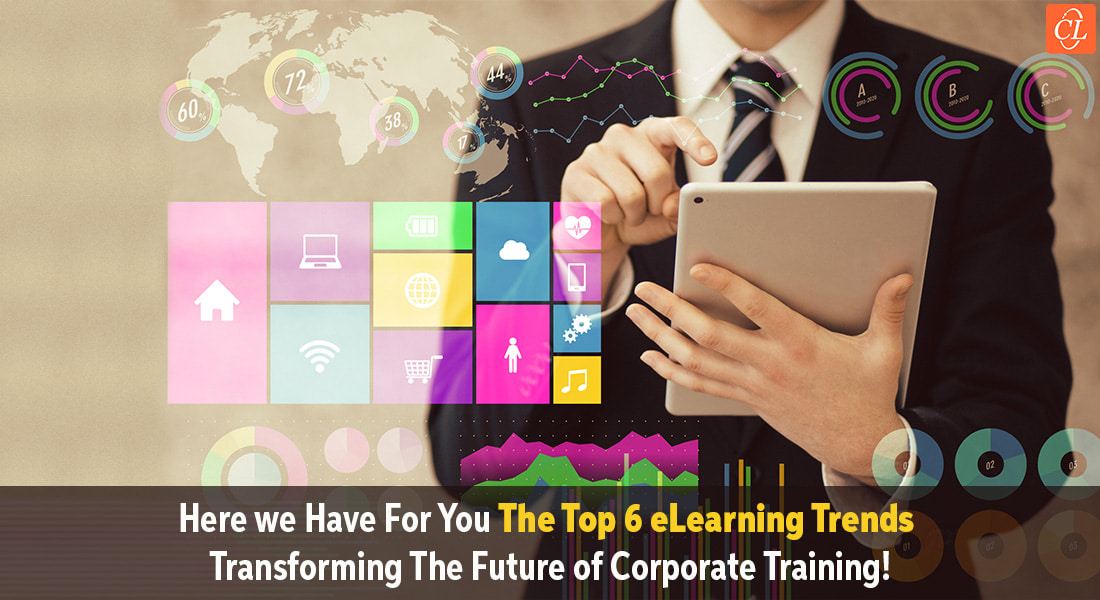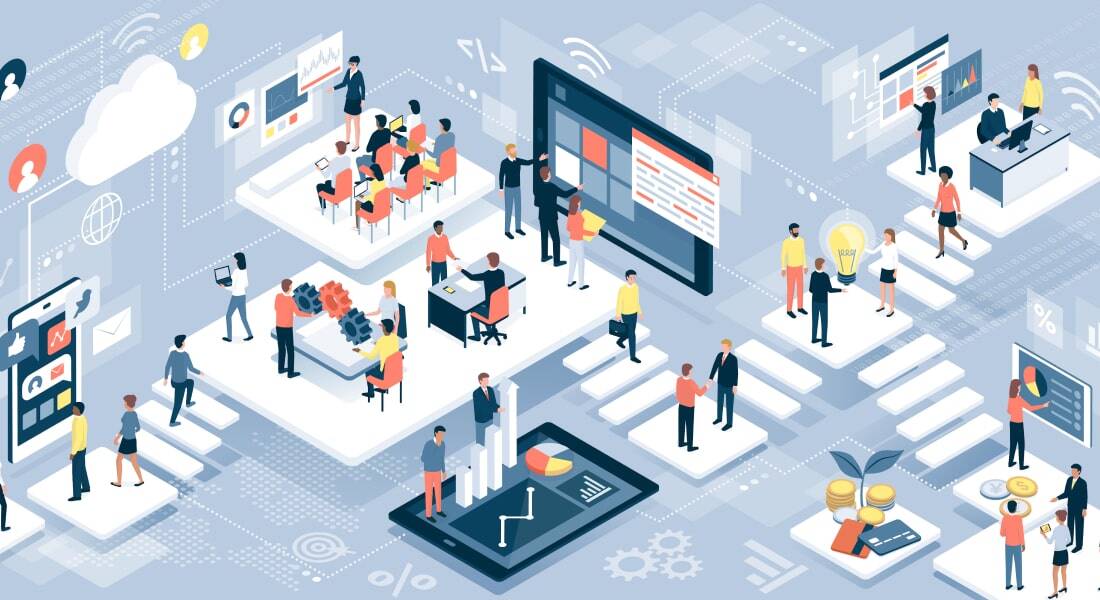Top 6 eLearning Trends Transforming Future Corporate Training

Even the most committed instructor may find it difficult to stay on top of the most recent eLearning trends. But as a fast primer, eLearning is going in the direction of more equitable and inclusive methods. The emerging patterns in digital learning are also shifting to more engaging forms, which largely rely on AR/VR and gamification to capture and retain learners’ attention. Additionally, eLearning has seen a few unanticipated advances.
In today’s digital environment, reskilling and upskilling are crucial. With the aid of efficient blended learning tools and models that seamlessly integrate learning and communication, learning and growth must be hands-on. To change training in the future, let’s look at the strengths of everything that should be in trend in your corporate training in 2022.
Wondering How to Transform Corporate Training in the Future?
Here are the Top 6 Trends to Look out for:
- Microlearning
- Gamification
- Augmented Reality and Virtual Reality
- Personalized Learning
- Mobile Learning
- Artificial Intelligence
Top 6 eLearning Trends Transforming Training in the Future
1. Microlearning
In the contemporary, fast-paced society that we live in, microlearning has grown to be an increasingly popular trend. Fundamentally, microlearning enables learners to acquire in-depth abilities by delivering essential knowledge in brief, bite-sized learning bites, as opposed to forcing them to invest hours in training.
Trainers communicate key ideas and assess learners’ retention and understanding using brief video clips, interactive games, and infographics assembled in a modular form. Microlearning facilitates information assimilation and recall. Modules are easy to create, edit, and deploy, and fulfillment/completion rates are substantially higher as by offering spaced learning, just-in-time learning, and memory retrieval assistance. These bite-sized modules thus help overcome the forgetting curve.
Discover how to create effective microlearning courses. Go here to access our free webinar recording!
2. Gamification
In workplace training, the term “gamification” means the procedure of turning traditional training materials into gamified eLearning programs. By essentially turning the learning content into a game, it seeks to boost learner engagement and information retention.
For many years, playing computer games on consoles, personal computers, and mobile devices has been a very common and addicting kind of recreation. As a result of this trend, many eLearning platforms are modifying their courses to include gaming features that promote learner engagement and interactivity by facilitating effective knowledge transfer, emotionally connecting learners, encouraging active participation, cultivating a sense of competition, and improving knowledge retention.
In addition to its cognitive advantages, gamified solutions may assist you in tracking the behaviors of your learners, such as time being spent on the learning platform. This and other pertinent learning information may be utilized to make critical decisions that will enhance your company’s performance.
3. Augmented Reality and Virtual Reality
With firms like Microsoft, Nvidia, Samsung, and Apple creating game-changing VR and AR devices and platforms, virtual reality (VR) and augmented reality (AR) have expanded tremendously since 2019.
The capacity of VR and AR to immerse learners in alternate universes and modify their training experiences is not only ground-breaking but also cutting-edge. In low-risk simulated settings, learners may take part in experiential eLearning wherein they deal with virtual items and understand ideas. These cutting-edge technologies can improve technical and scientific job performance including virtual surgeries, medical simulations, and the procedures and results of research and development in the industrial sector.
In corporate training, augmented reality (AR) gives learners more freedom by improving access to pertinent information and enabling real-time relationships with other instructors and learners.
With the use of virtual reality, users may design virtual meeting spaces where learners interact alongside teachers in real-time from any location. This immersive learning environment improves learners’ adaptability, information access, and communication abilities.
4. Personalized Learning
In its most basic form, personalized learning refers to learning that is tailored to the learner’s tastes and interests. Instead of following basic curricula, it allows people to grow their talents by working on specialized projects. In a brief, trainers may tailor the courses to the knowledge, skills, and areas of improvement of their workforce.
By analyzing learners’ demands considering their future jobs, this customization is feasible by factoring in the abilities that their employees must acquire, the trainer’s preset learning outcomes, and indicators. They also design related goals and benchmarks with clever rewards for their learners to accomplish and add appealing design features like customizable sprites, avatars, or characters to assist guided learning, and they’ll be all in.
The active learning paradigm of customized learning is one of the main factors contributing to its popularity. Additionally, learners who choose customized courses are goal-oriented, self-directed, and always expanding their sources of knowledge.
5. Mobile Learning
An increasing millennial workforce, as well as advancements in mobile technology, are all driving firms to use mobile learning for workforce training. Smartphones and other portable devices have become a necessary component of our everyday life in the modern era. Millennials like expressing their ideas, and a mobile learning program may create a platform for simple cooperation between workplace mentors and millennials. We utilize them for recreation, group communication, and accessibility to our preferred programs. Therefore, the incorporation of mobile-friendly technology into eLearning is imperative.
Mobile learning is gathering up speed thanks to the development of on-the-go technology like cloud technology and the availability of learning content on cellphones, notebook computers, and iPad and tablets. Simply said, the goal of mobile learning is to do away with the idea of in-person training, which is characterized by participant attendance, assessment, and engagement.
6. Artificial Intelligence
Just like how Netflix, an entertainment platform provides tailored learning experiences by assisting in the creation of learning paths and profiles with strong algorithms. Many eLearning programs and platforms now offer adaptive learning, by giving each employee individualized learning materials based on user preferences, rate of learning, and knowledge and skill gaps, personalized learning may hasten the learning process.
The automatic localization and translation capability is an excellent illustration of how AI technology is improving the efficiency and speed of the eLearning development process.
Therefore, AI can assist you in developing the most pertinent, interesting courses and training materials for upskilling and reskilling your personnel, regardless of where you are in your learning & development path.
Parting Thoughts
Being a part of the L&D team currently is amazing! to develop training programs that improve employee work performance! However, L&D needs to be hands-on with efficient technologies and blended models that make learning easier to achieve successful outcomes and make a difference. Check the webinar recording of “eLearning Trends 2022: The View from the Trenches” if you manage training programs or work in the L&D industry for great insights!





